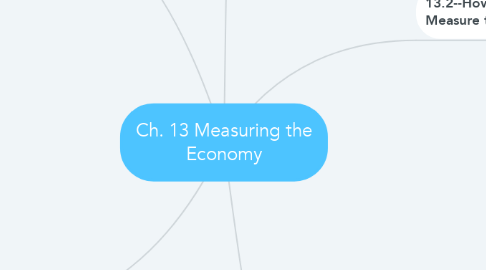
1. 13.4--What Does the Inflation Rate Reveal About an Economy’s Health?
1.1. 1. Economists at the BLS track changes in the cost of living using what is known as the consumer price index.
1.2. Consumers pay nominal costs with nominal wages, or wages based on current prices. As prices go up, wages generally go up as well. By using the CPI to adjust for inflation, economists can calculate real wages and compare them over time.
1.3. You are already familiar with one cause of inflation: an increase in the money supply. A dramatic increase in the amount of money in circulation can cause hyperinflation. But even a more modest increase may trigger inflation if the result is too many dollars chasing too few goods.
1.4. The BLS relies on the consumer price index to estimate the level of inflation in the United States each month. However, critics point to several biases that may distort the CPI, making the reported inflation rate less than accurate.
2. 13.5--How Does the Business Cycle Relate to Economic Health?
2.1. The business cycle consists of four phases. A period of economic growth is known as an expansion. The point at which an expansion ends marks the peak of the business cycle. Following the peak comes the contraction phase of the business cycle. The lowest point of a contraction is called the trough.
2.2. Business cycles are irregular in both length and severity. This makes peaks and troughs difficult to predict. Nonetheless, economists attempt to do just that, using a variety of economic indicators.
2.3. Business cycles are popularly known as periods of boom and bust. A boom is the expansion phase of the cycle.
2.4. On rare occasions, a recession will last a long time and cause serious damage to the economy. Economists refer to this kind of severe contraction as a depression.
3. 13.2--How Do Economists Measure the Size of an Economy?
3.1. 1. The main measure of the size of a nation's economy is its gross domestic product. GDP is an economic indicator that measures a country's total economic output.
3.2. 2.Economists use GDP figures to determine not only how big an economy is, but whether it is growing or shrinking and at what rate.
3.3. 3. Gross domestic product is a useful tool for measuring economic growth. But as a measure of the overall health of an economy, GDP has several limitations.
3.3.1. GDP leaves out unpaid household and volunteer work.
3.3.2. GDP ignores informal and illegal exchanges.
3.3.3. GDP counts some negatives as positives.
3.3.4. GDP ignores negative externalities.
3.3.5. GDP places no value on leisure time.
3.3.6. GDP says nothing about income distribution.
3.4. 4. As a country's per capita GDP increases, so too do other indicators of well-being, such as those listed.
3.4.1. Literacy and education.
3.4.2. Health and life expectancy.
3.4.3. Standard of living.
4. 13.3--What Does the Unemployment Rate Tell Us About an Economy’s Health?
4.1. 1. In its interviews, the BLS gathers detailed information about people who are unemployed. Based on those data and further research, economists identify four types of unemployment: frictional, structural, seasonal, and cyclical.
4.1.1. Frictional unemployment. Have you ever heard someone talk about being “between jobs”? This situation, which exists when a person has left one job and is looking for another, is what economists call frictional unemployment
4.1.2. . Structural unemployment comes about mainly when advances in technology reduce the demand for certain skills.
4.1.3. Seasonal unemployment occurs when businesses shut down or slow down for part of the year, often because of weather.
4.1.4. Every economy goes through prosperous times and hard times. Such cycles of growth and decline are the cause of cyclical unemployment. This type of unemployment occurs during periods of decline.
4.2. 2. Every month, the BLS reports the total number of people who were unemployed for the previous month.
4.2.1. Members of the labor force who have jobs are classified as employed.
4.2.2. Members of the labor force who are jobless, but are looking for work, are classified as unemployed.
4.2.3. Everyone who is eligible to be in the labor force but is neither working nor looking for work is classified as not in the labor force.
4.3. 3. When an economy reaches full employment, jobs exist for everyone who wants to work, even though a certain percentage of those jobs and workers will not yet have been matched together. Economists call this percentage the natural rate of unemployment.
4.4. 4. In determining how many of the country's more than 315 million people are unemployed, the BLS makes every effort to be accurate. Still, critics point to several problems that may make the results less than exact
4.4.1. The first problem is that at any one time, a number of unemployed people have given up looking for work.
4.4.2. The second problem is that the official unemployment rate does not recognize involuntary part-time workers.
4.4.3. A third problem with the unemployment rate involves people working in informal or underground economies.
